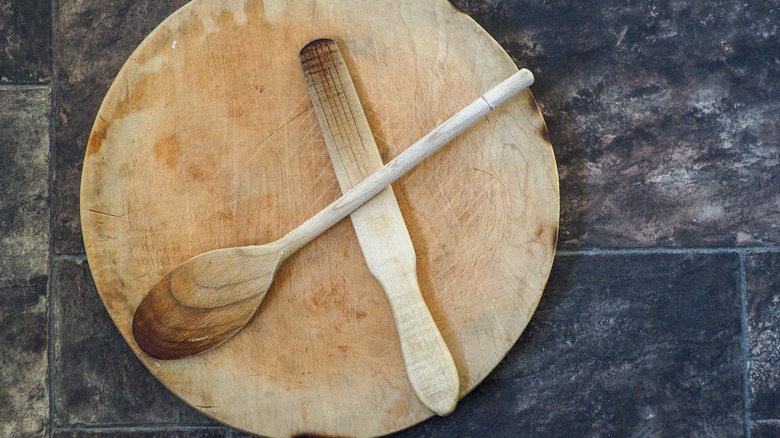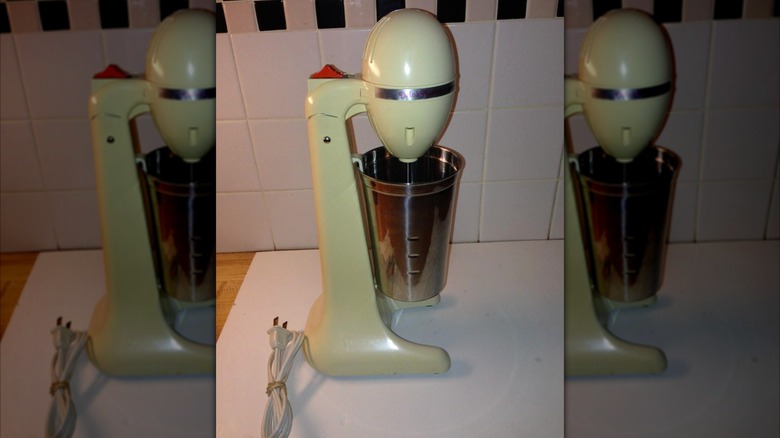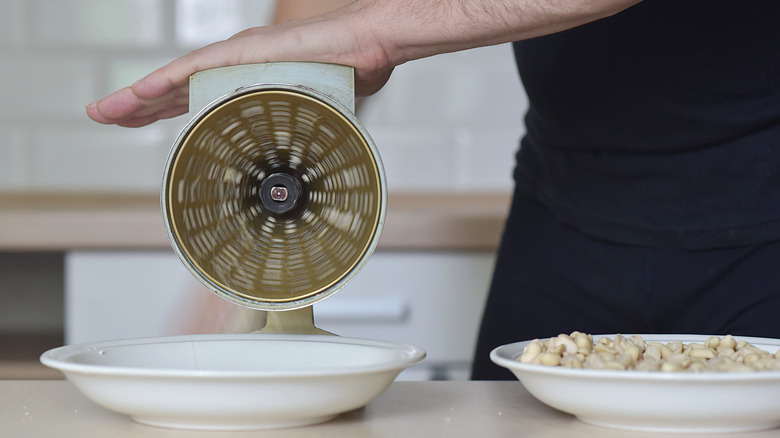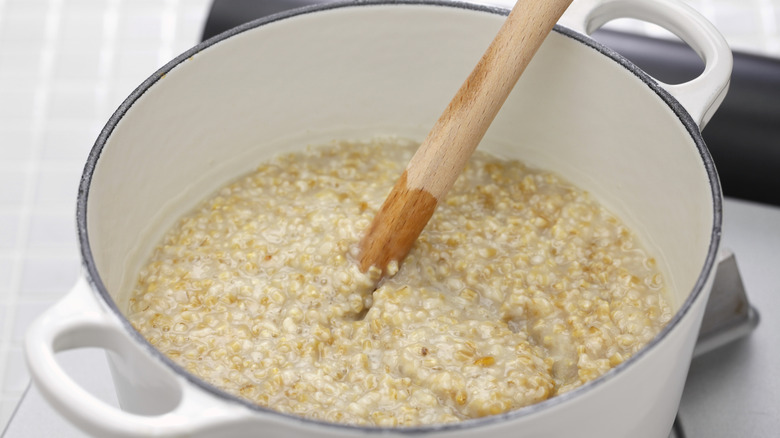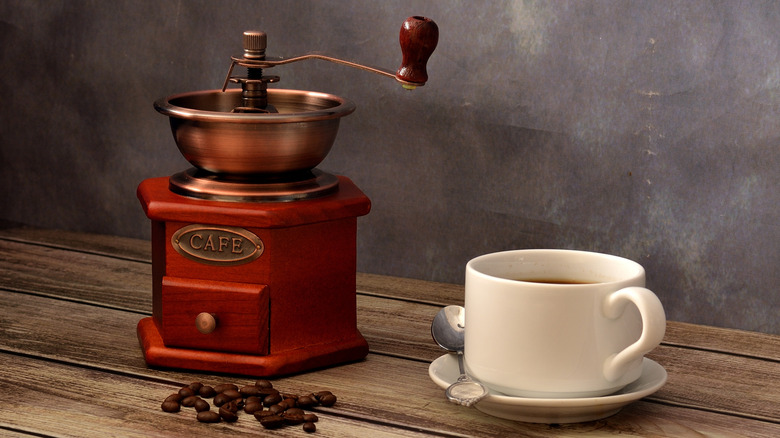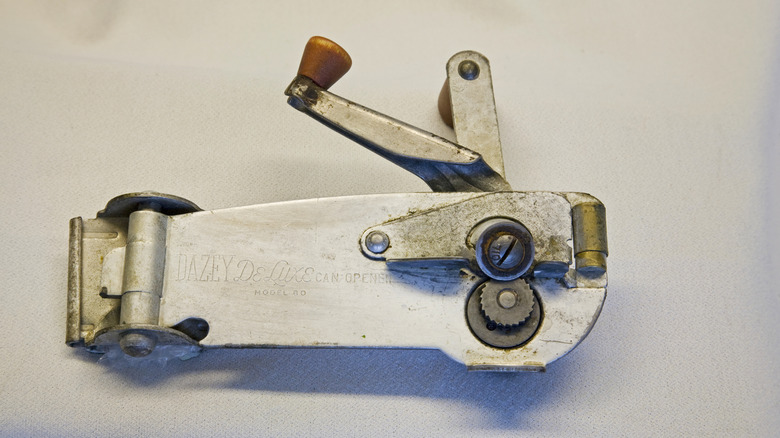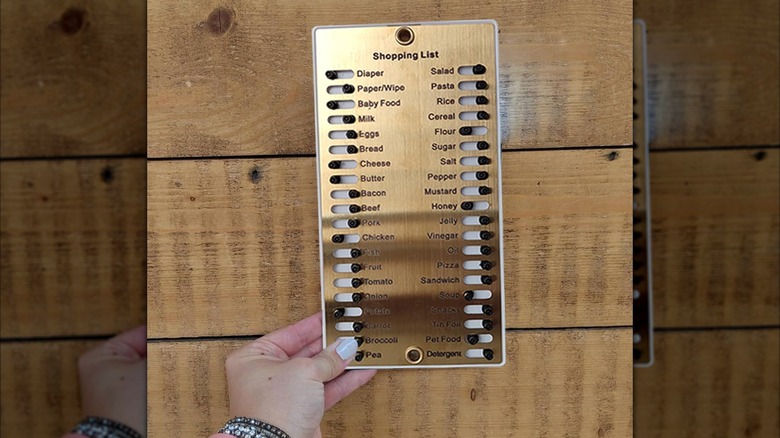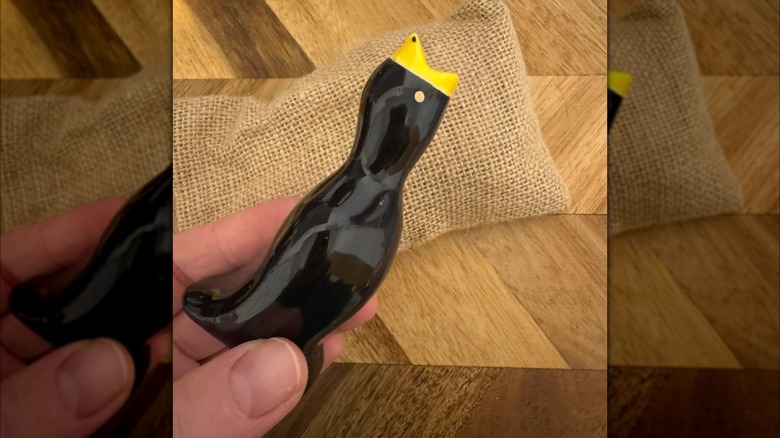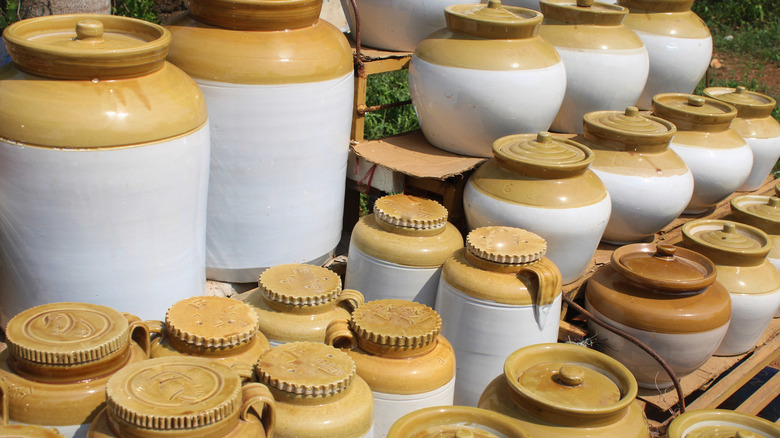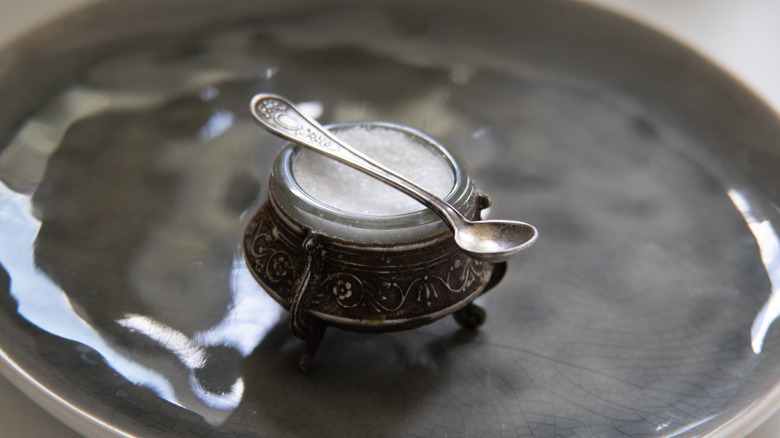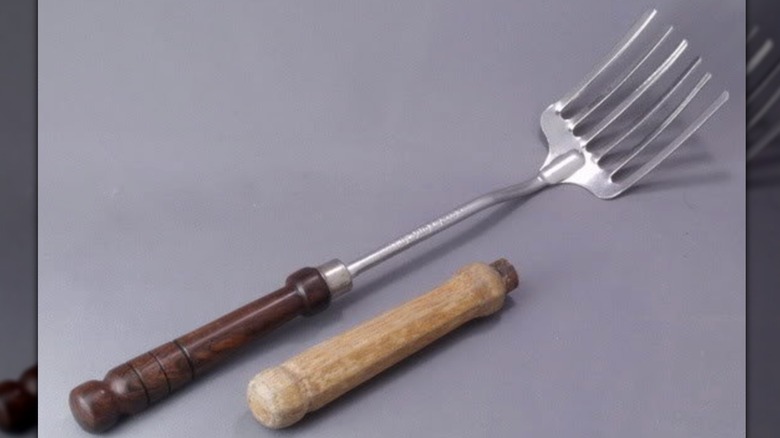10 Classic Kitchen Tools Your Grandparents Swore By
We may receive a commission on purchases made from links.
We're just gonna say it: Kitchens used to be way cooler back in the days of our grandparents. There's a focus these days on keeping kitchens tidy and streamlined, and that extends to the tools you use. Once you have all the essential tools you need, you should then focus on the aesthetics of your kitchen, rather than cluttering it with additional, one-time-use items. Sadly, though, we think that takes a lot of fun out of the equation. The generations above us had access to a host of classic tools that may have been a little more niche than the ones we use today, but which provided a clear solution to specific culinary problems. No wonder your grandma couldn't live without them.
While some of the simpler old-school kitchen tools are essentials for chefs like Giada De Laurentiis, many others have been phased out over the years. Items like the Foley fork, the pie bird, and the spurtle have all but disappeared from view. Others, like the Drinkmaster mixer, may still be in production but have been replaced by multi-purpose tools. Well, we think it's time to bring some of these old-school kitchen tools back, folks. From wall-mounted can openers to pickling crocks, here are our favorites.
1. Hamilton Beach DrinkMaster mixer
If you ever enjoyed a classic-style vanilla milkshake at your grandma's house when you were a kid, chances are it was made with a DrinkMaster mixer. This appliance, made by Hamilton Beach, is still being made to this day, but its heyday was well and truly back in the early-to-mid-20th century. The flagship product for the appliance company was first sold in 1934, and pretty soon it was sitting on counters in soda fountains, milkshake shops, cafes, and restaurants around the country. It subsequently also became a household appliance, with people whizzing up mixed drinks in the comfort of their own kitchens.
The Hamilton Beach DrinkMaster mixer is a pretty bulky machine, though, and over time, people gradually realized that they could get the same result from the more streamlined blender. Blenders are also way more multi-purpose than the DrinkMaster, and its popularity began to fade as folks incorporated their appliances' functions into one machine. Nowadays, it feels a little frivolous to have one, but if you've ever wanted an appliance that's solely dedicated to creating mixed beverages, it's a stylish, cool addition to your countertop.
2. Nut grinder
Cooking with nuts often requires the ground version, and nowadays it's very easy to find packages of them in virtually any major supermarket. Back in your grandparents' era, though, things weren't as simple. If a dish called for ground nuts, it meant that people had to do it themselves, and there was clearly a market for a machine that would help avoid the elbow grease that went into that task. The nut grinder was invented to answer this call. A more specific version of the food mill, these charming little machines would sit on top of your chosen container, and nuts would be fed into it. You'd then use a crank on the side that would spin metal teeth in its interior, and the nuts would be ground up uniformly.
These machines were both affordable and attractive, but there's no denying that they were also very specific. As time went on and appliance technology developed, people realized that they could incorporate all (or at least most) of their grinding needs into one machine — and as electricity came into the kitchen more and more, nut grinders were replaced by modern food processors. However, there's still a certain charm to milling your nuts by hand.
3. Spurtle
The spurtle isn't just something that your grandparents may have used — it's something that their ancestors may have employed as well. This tool, which has perhaps the most delightful name of any kitchen utensil, was invented way back in the 15th century in the Scottish Highlands. It is, essentially, a smooth wooden stick that has the sole function of stirring porridge. Spurtles can come in the shape of a thistle, hearkening back to their Scottish origins, or they can have broad, flat shapes that can help to push the porridge around more effectively.
It sounds like a pretty useless tool, right? Apart from making a truly authentic Scottish porridge, what's the point of having one? Well, we wouldn't discount the glory of the spurtle just yet. This tool may have a very specific function, but its slim and streamlined nature gives it the edge over a wooden spoon when making porridge. Spurtles help to stop your oats from clumping as they cook on the stove, giving your breakfast a smoother consistency. Aside from this, they're also super useful for stirring soups and sauces, and crushing up veggies like tomatoes. Oh, and they're also quite attractive. Save your wooden spoons and grab yourself a spurtle; you won't regret it.
4. Manual coffee grinder
You should probably stop buying ground coffee altogether, but what did people do before they could grab those convenient little bags in stores? They'd have to grind it themselves, of course. Many kitchens in the homes of people who drank coffee would contain coffee grinders, which have been around in hand-cranked form since the 17th century. Before this, people would grind their beans using a mortar and pestle.
The 19th century saw the popularity of manual coffee grinders explode as factories in the United States started producing widely available models, and while these tools were big and bulky, they got the job done. Soon, however, electricity took over. The first electric coffee grinder was created in 1913, and soon after that, it became a go-to appliance for people looking to make the job of breaking down beans a little easier.
Nowadays, if you're not buying pre-ground coffee, you're likely grinding your beans in a little electric device (or just feeding them into your coffee machine). That doesn't mean manual coffee grinders have gone away, though: There are plenty of hand-operated models out there today that combine a contemporary feel with that classic crank mechanism.
5. Wall-mounted can openers
Whatever happened to wall-mounted can openers? The very first versions started appearing in the 1930s, and were hand-cranked affairs that relied on nothing but the motion of the wrist to open up your canned goods. These manual appliances were soon replaced by midcentury electric models, which were commonly installed under kitchen counters and would make the work of opening a can a real breeze. Towards the end of the 20th century, though, wall-mounted can openers started to be replaced by handheld ones that you could place in your kitchen drawers after you were finished. They took up way less space and cost a lot less money.
Nowadays, wall-mounted can openers (especially manual ones) are largely a thing of the past — and we think that's a bit of a shame. They may not have been the most practical things in the world, but they undeniably gave kitchens a lot of pizzazz. You can still buy wall-mounted can openers if you look for them, but they're way less common.
6. Metal grocery list
Sometimes, a classic kitchen tool comes along and provides a solution to a problem you didn't even know you had. That problem is this: We're always either losing our manual shopping lists, or unable to find the one we quite literally just made in our Notes app — seriously, where do they go? Back in the day, this issue was easily solved by the metal grocery list.
These devices, which would come in all different shapes and sizes, had two columns of all the essentials you'd usually buy during a shopping trip and a toggle next to each one. As the week went on and you ran out of items, you could flick the toggle next to each thing you'd need to buy when you next went to the store. Then, you could take your handheld metal grocery list to the shop with you, and flick the toggles back as you put them in your cart. Pretty cool, right?
Sadly, it seems like the metal grocery list simply went out of fashion as time went on. Perhaps it was because there was no customization possible with these tools, and as new items became popular and people's tastes got broader, the grocery list remained fixed and unchanging. We think there's a lot of scope for these to come back into fashion, though.
7. Pie bird
Buckle up, folks: We're about to introduce you to the most charming kitchen tool you'll ever see. The pie bird was a 1930s invention with a history rooted in Victorian baking (and has origins even older). Bakers of yesteryear would frequently place an item called a pie funnel into their pies, which would allow steam to escape and prevent the bottom from going soggy. Once the 20th century arrived, people started making their pie funnels more aesthetically pleasing and manufacturing them in little bird shapes with upturned beaks, with the steam escaping from a vent in their open mouths. The pie bird was born.
In the 1940s, pie birds began to be produced more widely, and they became kitschy-but-useful items for any budding home chef. However, people eventually started to see the downsides of using pie birds, with the main one being that shoving them in the middle of your pie would leave the lid with a big hole in it after it was cooked. Cooks eventually started to revert to using lattice lids or scoring the top of their pies to allow steam to escape, and the pie bird faded into obscurity.
8. Pickling crock
It feels like pickling has never been more in fashion, which is kinda ironic considering that it's one of the oldest food preparation methods out there. Pickles are a historically essential part of many cuisines, and pickling is such a cornerstone of cultures around the world that families would typically have dedicated vessels to make them in. These weren't the cheap plastic receptacles that amateur sauerkraut makers typically make do with today, either. No, folks, they would use a pickling crock — stoneware that was specifically designed to pickle and ferment food items in.
Pickling crocks were a must-have item for cooks in North America going all the way back to the 18th century, but in other parts of the world, they've been around even longer. Korean onggi, for example, have been made since approximately 5,000 B.C., and have been the traditional vessel for preparing kimchi for thousands of years. Nowadays, though, the availability of store-bought pickles has rendered pickling crocks somewhat useless in a lot of kitchens, and a lot of people just use Tupperware instead, but we think that's taken a lot of the charm out of the pickling process. Never fear, though: If you want to do things how they did in the olden days, you can still buy a pickling crock online from plenty of different places.
9. Salt cellar
The salt cellar used to be way more popular than it is today, and while it's somewhat back in vogue, you're far more likely to get your salt from a shaker or grinder. We think that's a shame. Salt cellars date all the way back to antiquity, where they were typically ornate creations made from silver, used to display wealth and status (after all, salt was extravagantly expensive in ancient times). As time went on, traditions emerged around salt cellars and their symbolism, with cellars placed in front of guests to signpost their social standing and significance at dinners and functions.
Eventually, salt cellars became items that were placed in the middle of tables, but they remained elaborately designed items that served as centerpieces. Then, the 20th century brought about the rise of anti-clumping agents in salt, which led to the rise of the salt shaker. Salt cellars became less and less common — although interestingly, they're now a status symbol in a slightly different way, with chefs using them over shakers to signify a "classier" approach to cooking. Even though their designs these days are simpler, with models like the Le Creuset Signature Salt Cellar having a streamlined feel, they still add a touch of elegance to your kitchen.
10. Foley forks
You could be forgiven for thinking that the foley fork was some kind of garden tool, or else some strange AI-generated image. In fact, it was (and is) a useful kitchen utensil that's somewhat faded into obscurity after having its heyday in the 20th century. The Foley fork was created in the 1920s and is, in essence, a six-pronged fork with a wider head than a regular one. It may well have never taken off at all, but its popularity was boosted by Julia Child, who used a Foley fork on her famous television show "The French Chef."
Soon after, though, the Foley fork was written off as a midcentury curio, and it's fairly rare to find one in kitchens these days. We personally think that's a real tragedy. It may not seem like it, but this fork is way more useful for everyday tasks like beating eggs, mixing cake batter, and mashing up various foods than a regular fork. Its wider head covers a greater surface area and stops it from being so prone to bending.
